
accidentally mis-sizing fillets on a character lead to this …

accidentally mis-sizing fillets on a character lead to this …

[photo from ‘Significant number’ of Canadian Ranger deaths flagged by military chaplain, (Chris Wattie/Reuters)]

Rods! Or more specifically, Cuisenaire® Rods! Staples of my childhood arithmetic education: coloured wooden rods (now plastic, which will save them from the mouldy fate that befell some sets at Mearns Primary School), 1 × 1 × 1–10 centimetres long. Use them for counting, number lines, don’t-do-that renditions of Sun Arise, but absolutely never for flinging at tiny classmates.
Since it may actually have been Mrs. Cuisenaire who came up with the concept of rods, I drew a log cabin quilt section in virtual rods. The Gattegno in the title refers to Caleb Gattegno, the mid-century educator who popularized Cuisenaire’s work.
Should you too feel the need to have a virtual set of rods, here are some files you can play with in Inkscape (or any other SVG-aware editor):
The colours might be a bit off reality, but they’re near enough. I found it helpful to set a grid snap in Inkscape to 1 cm so that you could get the rods to align easily. If you want to get really nerdy, here’s the PostScript source I used to create the rods: rods.ps. I think I finally got the hang of basic arrays in PostScript …
Creating this was in no way a means of me displacing getting round to doing my taxes this year, nosirree.
Instagram filter used: Normal

Instagram filter used: Normal
I made this after being inspired by this MetaFilter comment. There’s a PDF linked from the image below:
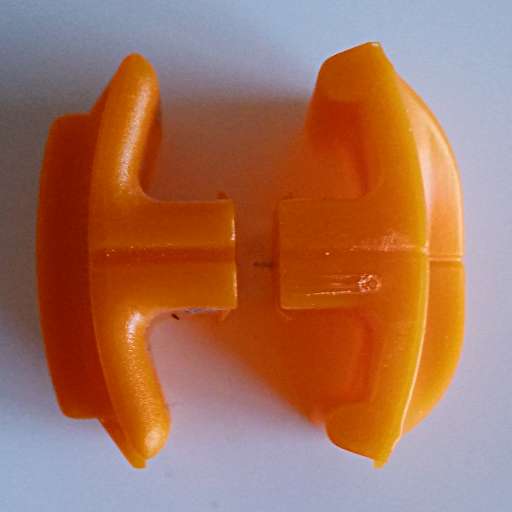
On the left, a very worn blade from a roughly decade-old Fiskars paper trimmer. On the right, one of the replacement blades you can get at Staples. Note the extra lugs stopping the new-style blades working with the old-style cutters? Bet they think they’re really clever little Fiskars for coming up with that planned obsolescence move.
It’s nothing that a steady hand and a rotary tool can’t fix, though …
After a relative lack of success in making cheap plotter pens, I managed to score a trove of old pens on eBay. Some of these were dry, and I tried to resuscitate them. A few came back to life, but I ended up with a handful of very dead pen shells.

I think the pens were made or sold by Alvin, as there were several empty Alvin trays in the batch I got on eBay. In taking one apart, I thought that a pen refill might just slide inside. Lo and behold, but didn’t the pen nerd’s fave gel pen du jour refill just slide in with enough of an interference fit that it wouldn’t easily slide back out.
Taking the dry pens apart isn’t too easy:
Converting the pen body to use a Jetstream refill needs some tools:
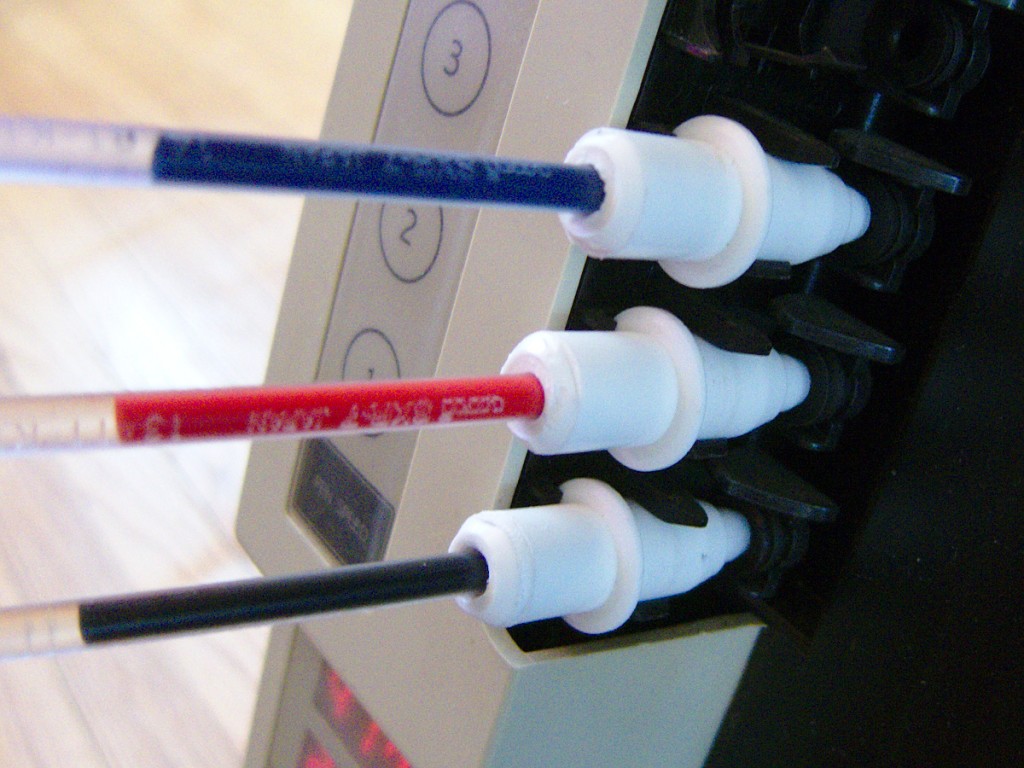
To get best results, you’ll have to slow your plot speed down quite a bit. At standard speeds, you get a ¼ mm interrupted line which looks like this:

Close up, the lines are really faint
 A hint that I should run them slower was at the start of each line, where the line would start very thick, then taper off as the ink supply ran low:
A hint that I should run them slower was at the start of each line, where the line would start very thick, then taper off as the ink supply ran low:
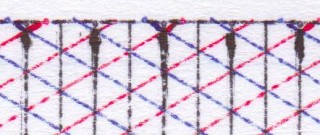
Run at 120 mm/s, the results where a bit darker, but still blobby at the start of lines:

Slowing down to 60 mm/s produced slightly better results:

But sharpest of all was at the crawling speed 30 mm/s:

Some pronounced blobs at the starts of lines still. Here’s the full page at 600 dpi, squished into a very lossy PDF: jetstream_plotter-slow
The blobs could be due to this, though:
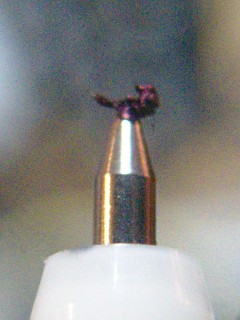
It seems that a mix of paper fibres and coagulated ink builds up on the tip. Occasional cleaning seems to be a good idea. It also seems to help to draw a quick scratch line before anything important so the ink will be flowing properly.
Just to sign off, here’s one of the pens in action:
I saved an archive of Robert Bradford’s mktartan program on github: scruss/holestone-tartan (local cache: holestone-tartan-master) to stop it falling apart completely from bitrot.
 Inspired by Robert Howsare’s Drawing Apparatus, a time-step simulation of a similar apparatus was developed. Each trace was made of thousands of straight line segments, one for each rotation of the turntables’ drive motors, and enough to create a closed figure. Suitable gearing was modelled to simulate standard (North American) gramophone speeds of 16â…”, 33â…“, 45 and 78â…• rpm for each of the turntables. Drive crank lengths were derived from standard record sizes. The initial starting angle of each turntable was also modelled.
Inspired by Robert Howsare’s Drawing Apparatus, a time-step simulation of a similar apparatus was developed. Each trace was made of thousands of straight line segments, one for each rotation of the turntables’ drive motors, and enough to create a closed figure. Suitable gearing was modelled to simulate standard (North American) gramophone speeds of 16â…”, 33â…“, 45 and 78â…• rpm for each of the turntables. Drive crank lengths were derived from standard record sizes. The initial starting angle of each turntable was also modelled.
Three simulation runs were chosen and superimposed. The result was plotted on “A†size vellum using 0.3 mm ceramic drafting pens. Total plot time at 90 mm/s: 22 minutes.
Code available on request.
It’s the Canadian Electricity Association’s Electricity in Ontario week. Can’t you feel it in the air? A brochure, snappily titled “ELECTRICITY ARE WE GETTING VALUE FOR THE MONEY WE PAY?†[pdf] was in my dead tree media stack this morning. I think it’s trying to say our power is too cheap, as in this graph yoinked from the text:
But as ever, hand-picked statistics only tell half the story. Digging into the IEA Key World Energy Statistics handbooks for 2011 and 2012, the data look something more like this:
|
Country |
2010 Domestic Electricity Price / USD/kWh |
2010 Annual Electricity Consumption per capita / kWh |
Annual Cost per capita |
|
Denmark |
$0.356 |
6,329 |
$2,255 |
|
Japan |
$0.232 |
8,399 |
$1,950 |
|
United Kingdom |
$0.199 |
5,741 |
$1,142 |
|
France |
$0.157 |
7,756 |
$1,216 |
|
United States |
$0.116 |
13,361 |
$1,547 |
|
Canada |
$0.095 |
15,145 |
$1,431 |
|
Mexico |
$0.089 |
2,085 |
$185 |
So really, because Canadians use such an obscene amount of energy per capita (srsly; we should be ashamed of ourselves), the graph should look more like this:
So we’re not actually that inexpensive; solidly mid-range. Since our electricity price per kWh is so low, if we spent a little money on energy conservation, we could have really cheap power for everyone.
Well, look at this:
$ stty -F /dev/ttyACM0 speed 115200 raw cs8 $ rngtest -t 6 < /dev/ttyACM0 … much snippage … rngtest: bits received from input: 312368864 rngtest: FIPS 140-2 successes: 15602 rngtest: FIPS 140-2 failures: 16 rngtest: FIPS 140-2(2001-10-10) Monobit: 2 rngtest: FIPS 140-2(2001-10-10) Poker: 2 rngtest: FIPS 140-2(2001-10-10) Runs: 8 rngtest: FIPS 140-2(2001-10-10) Long run: 4 rngtest: FIPS 140-2(2001-10-10) Continuous run: 0 rngtest: input channel speed: (min=837.317; avg=1168.033; max=1948.060)Kibits/s rngtest: FIPS tests speed: (min=16.834; avg=27.779; max=77.221)Mibits/s rngtest: Program run time: 271917796 microseconds
Over a megabit/second of decent quality random data. This is from an Arduino Due, which has an Atmel SAM3X8E ARM Cortex-M3 microcontroller on board. I hadn’t found much use for this board previously, as it fell between a regular 8-bit Arduino and my (many!) Raspberry Pis.
This changed when I found out about Walter Anderson’s Entropy library, which uses µc timer jitter as a source of entropy. Originally designed as a slow but true source of random integers on the Atmel AVR chips, it’s been extended to use the SAM3X8E‘s built-in hardware RNG. Since the Due has a native USB port, you’re not limited to standard baud rates.
Here’s the code, trivially modified from one of Walter’s examples:
// Generate_Random_Bytes_Due - speedy demo of Arduino Due's HWRNG
// based on Generate_Random_Bytes, for Entropy, an Arduino library.
// Copyright 2012 by Walter Anderson
//Â modified - scruss - 2014-08-13
// remember to reconnect to native USB port
#include <Entropy.h>
void setup() {
 SerialUSB.begin(115200);
 while (!SerialUSB) {
   ; // wait for serial port to connect.
 }
 Entropy.initialize();
}
void loop() {
 uint16_t r = Entropy.random();
 SerialUSB.write(lowByte(r));
 SerialUSB.write(highByte(r));
}
It’s a minor pain to have to reconnect the USB cable to the other port on the Arduino Due after programming, but it’s worth it just to see an 84 MHz µc belting out random bytes 37½% faster than an 800 MHz Raspberry Pi …

(source: https://gfycat.com/PinkEmptyGyrfalcon)

For more details, please see The Solarbotics Solar Marble Machine.
Music: “A New Way of Seeing” — (excerpt) – Richard Harvey; © 1979, ICL.
I’d just like to go on the record that Intel made me accept these Terms & Conditions when logging on their Space: Makers | Intel Communities site: Yup, completely blank. I guess I can do anything I want now, eh?
Yup, completely blank. I guess I can do anything I want now, eh?
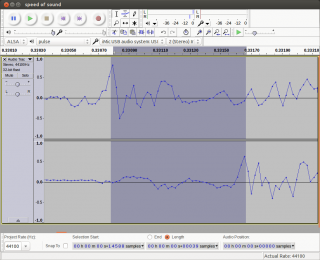 With a pair of binaural mics placed 33.7 cm apart feeding into a stereo USB sound card (a Griffin iMic), I clapped near the left mic. It took 39 samples (884 µs) for the peak to travel between the microphones. That gave me a speed of sound of 381 m/s. A bit high, but the conditions this evening weren’t ideal, and I only set up the experiment with cursory care.
With a pair of binaural mics placed 33.7 cm apart feeding into a stereo USB sound card (a Griffin iMic), I clapped near the left mic. It took 39 samples (884 µs) for the peak to travel between the microphones. That gave me a speed of sound of 381 m/s. A bit high, but the conditions this evening weren’t ideal, and I only set up the experiment with cursory care.
The iMic seems unusual in having a stereo line/mic input. Most other (cheaper) USB dongles only have a mono input.